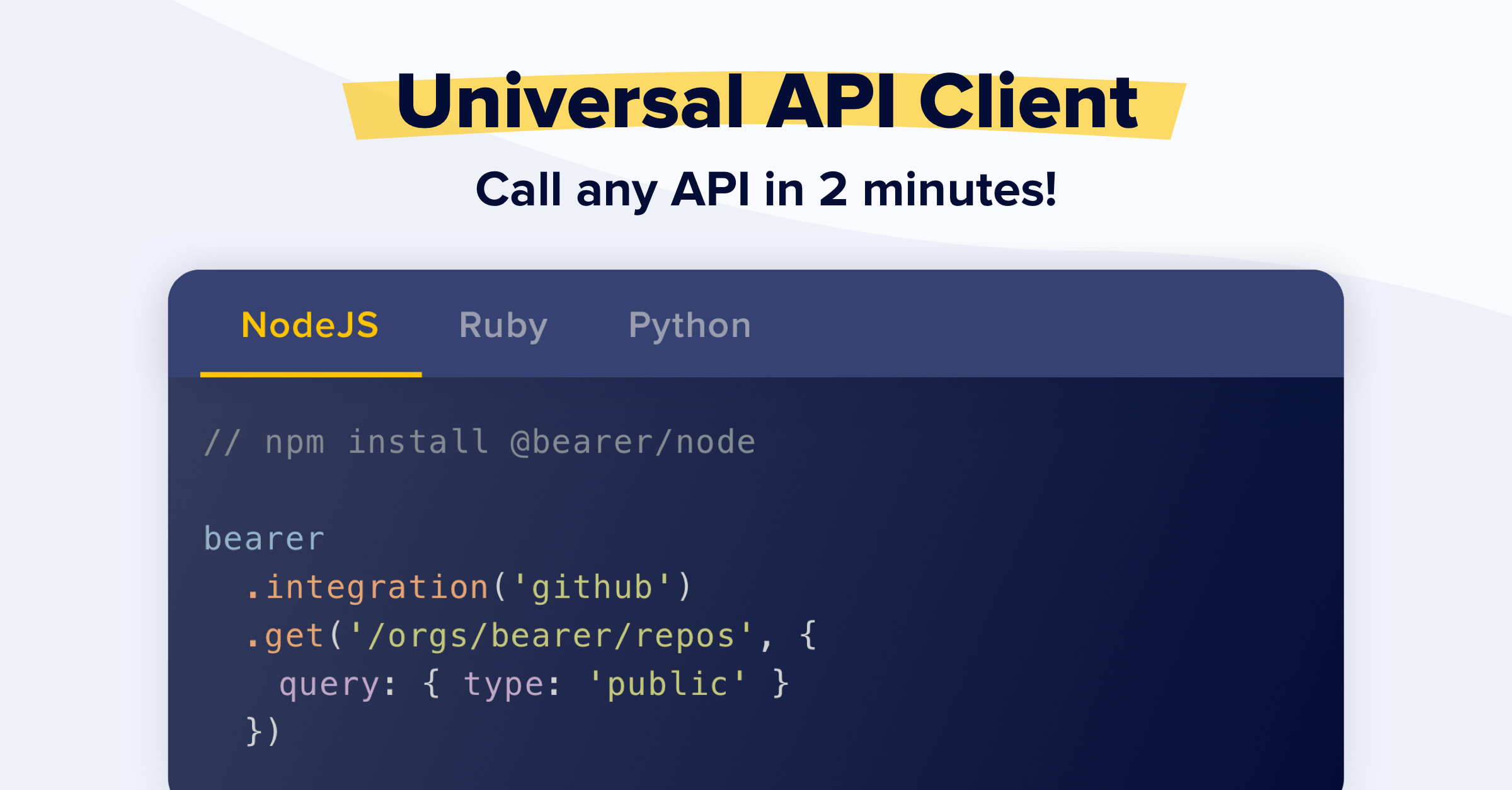Bearer - The API Integration Framework
Bearer provides all of the tools to build, run and manage API
Learn more


Table of contents
Why
You should use Bearer if you want to:
- Consume any API in minutes
- Map API endpoints to your app model
- Integrate into your code with one line
- Deploy and Scale without fuss
- Monitor every API call
- Manage your integrations
Installation
# Using yarn
yarn create bearer helloWorld
# Using npm
npm init bearer helloWorld
# Using npx
npx create-bearer helloWorldQuick Start
Follow the quick start to create your first integration.
Documentation
The documentation is available on the Bearer doc center.
Command References
The Framework comes with a Command Line Interface (CLI) providing many commands:
$ yarn bearer -h
Bearer CLI
VERSION
@bearer/cli/rc-1
USAGE
$ bearer [COMMAND]
COMMANDS
autocomplete display autocomplete installation instructions
generate generate function
help display help for bearer
integrations list deployed integrations
invoke invoke function locally
link link to remote Bearer integration
login login using Bearer credentials
new generate integration boilerplate
push deploy integration to Bearer
setup setup API credentials for local development
start start local development environmentFind below some explanation of commands by order of importance.
New
As an alternative to the yarn create bearer command, you can also use the new command:
yarn bearer newSetup
This command help you setup your (test) API authentication credentials in local development:
yarn bearer setup:authGenerate
The generate command provides a fast and easy way to bootstrap a function, taking care of much of the boilerplate code:
yarn bearer generate:function FunctionName
Invoke
The invoke command let you run a function directly from the console:
yarn bearer invoke FunctionNameIt's a great way to test and debug a function.
You can also pass arguments, as a JSON file, to the invoke command, which are translated as params to the function:
yarn bearer invoke FunctionName -p tests/function.json{ "params": { "fullName": "Bearer/bearer" } }NB: The file path is relative to the integration folder.
Start
The start command provides a local Web Server to test the integration:
yarn bearer startBehind the scene, it builds the integration (transpiling code, etc...) and manage things like live reload.
Push
The push command let you deploy your integration to the platform
yarn bearer pushLogin
The login command let you connect to the platform from the CLI:
yarn bearer loginIt's a required step in order to push your integration.
Link
The link command let you link an integration registered on your bearer's dashboard with your current integration code:
yarn bearer linkNB: This command is triggered automatically when you deploy an integration for the first time.
Integrations
The integrations command let list your deployed integration and also create a new one:
yarn bearer integrations
yarn bearer integrations:createContributing
We welcome all contributors, from casual to regular
- Bug report. Is something not working as expected? Send a bug report.
- Feature request. Would you like to add something to the framework? Send a feature request.
- Documentation. Did you find a typo in the doc? Open an issue and we'll take care of it.
- Development. If you don't know where to start, you can check the open issues.
To start contributing to code, you need to:
- Fork the project
- Clone the repository
- Checkout the Getting Started
License
Bearer is MIT licensed.
